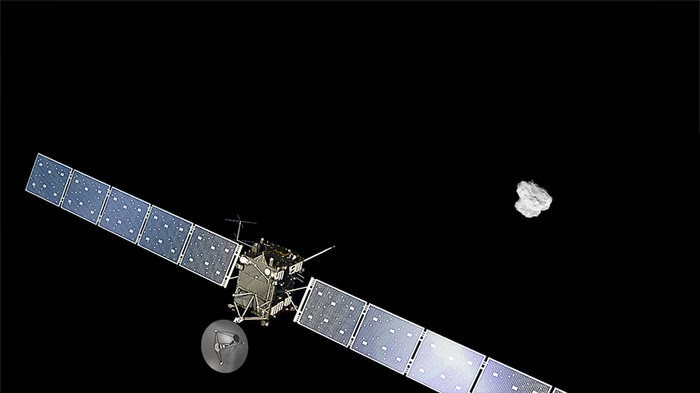 |
| Artist’s rendition of Rosetta approaching comet 67P Image Source: ESA |
For the next few days (and probably many many years), you are likely to come across people speak of the greatness of ‘Rosetta’ and about her achievements and before you start thinking that the Rosetta is some entrepreneur, social worker, sportswoman or the worst, a movie star, let us make it very clear that Rosetta is actually a spacecraft. and still a Superstar!
Here are 5 things that have make Rosetta famous!
- Rosetta, is a spacecraft built by the European Space Agency, at a cost of 1.3 billion Euros, with the aim to study the comet 67P/ Churyumov- Gerasimenko. Discovered in 1969, the comet orbits around our Sun every 6.6 years and Rosetta’s mission to understand what this comet is made up. The mission will give us scientists further information on how our Solar System originated and evolved, since our Sun, planets and all the comets are made up of the same pre-solar nebula that existed over 4.6 billion years ago.
- Approved in the year 1993, the mission was launched in March 2004 with the aim of rendezvousing the comet in the year 2014. Meticulous planning and complex calculations were an integral part of this mission, since no rocket could have been deployed to put Rosetta directly near the comet. Instead, the spacecraft performed four flybys, three around our Earth while one around Mars to get itself into the right trajectory and speed to get to the comet 67P. This 10 year long journey also involved a 31 month hibernation (between June 2011 to January 2014) where all electrical systems were put off, except for radio communication to conserve fuel.
- After waking up from hibernation, Rosetta was 9 million kilometers away from its target, the 67P comet and travelled this distance between January & August then slowed down in 10 extremely delicate maneuvers to match its pace with that of the comet.
- On the 6th of August 2014, Rosetta was moved to a triangular orbit around the comet at a distance of about 30 kms from the surface. Over the next few months, the spacecraft will closely monitor the comet, take pictures of its surface and identify areas for landing its probe, Philae.
- Philae, is the probe will attempt to make a landing on the 4 kilometre wide comet 67P in November later this year depending on the data that Rosetta manages to gather in the coming few months. The probe is laden with three spectroscopes to investigate the core of the comet and also a microwave radio antenna along with a radar.
 |
| Artist’s rendition of Philae on 67P. Image source: ESA |
Sun at a speed of 55000 kilometers per hour. Researchers at the European Space Agency are hopeful that the spacecraft and its probe will continue to work even when the comet nears the Sun and bring us information of the changes that a comet undergoes while orbiting closer to the Sun and help us understand them better. The project is scheduled to end in 2015, but will continue investigating the comet further, if sufficient fuel is available after this time.


